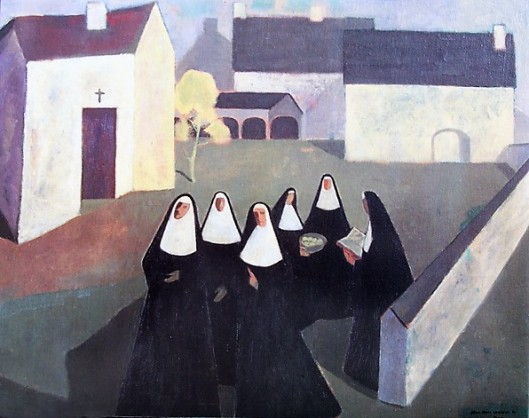Tags
Claude Léveillée, Gilles Vigneault, Jean Paul Lemieux, Jean-Pierre Ferland, La Capricieuse, Le Vieux Soldat canadien, les Ursulines, Mon Pays, Raymond Lévesque, Robert Charlebois

Les Ursulines, Jean-Paul Lemieux, Wikiart
It’s Sunday, which remains a sacred day for me. Other days serve different purposes and have an origin. Saturday is Saturn as in Saturnalia, a Roman festival taking place on the day of the longest night: Christmas. Humanity has always cherished symbols, but these change from culture to culture. They attach a story to things otherwise “ordinary.”
Jean-Paul Lemieux
To decorate my post, I chose Jean-Paul Lemieux (18 November 1904 – 7 December 1990) who lived in Berkeley, California for several years. His family may have wished to escape cold winters. He and Leclerc were born the same year and were good persons. Lemieux returned to Québec, despite the cold, the snow, various ice storms and numerous heat waves.
Félix Leclerc
Félix Leclerc (2 August 1914 – 8 August 1988), was born in La Tuque, Quebec and studied at the University of Ottawa until the Great Depression. There was no money. He then found work in radio stations, as speaker or writer. In 1939, he was employed by Ici Radio-Canada, the French counterpart of the Canadian Broadcasting Corporation, the CBC. He may have written radio dramas, which my father did, at approximately the same time in the history of Quebec.
After the war, Félix Leclerc, and his guitar, went to France where he took courses. He met kindred spirits, such as Boris Vian. In 1950, at the age of 36, he was discovered by French impresario Jacques Canetti. His daughter says that he divided his life between l’île d’Orléans, where he owned a house, and Paris.
In Le Tour de l’île, Leclerc also mentions a blue-eyed grandfather standing guard, which reminds me of Octave Crémazie‘s poem, entitled « Le Vieux Soldat canadien » . The first French ship to sail down the Saint Lawrence after the “Conquest” was La Capricieuse, in 1855.[1]
Other Quebec Singer-Songwriters
Félix Leclerc was the first of a group of Quebec singer-songwriters. These include Raymond Lévesque who wrote “Quand les hommes vivront d’amour,” Claude Léveillée who wrote songs for Édith Piaf, and also wrote Frédéric (1961), is also a major singer-songwriter. So are Jean-Pierre Ferland, the composer of Fais du feu dans la cheminée, Robert Charlebois, the author of Ordinaire, and Diane Dufresne. The best performers were Monique Leyrac and Pauline Julien. (Please click on the title of songs I have chosen to hear it.)
However, the most celebrated Québecois singer-songwriter is Gilles Vigneault. Vigneault wrote: “Mon Pays.”
Independence
You will have noticed that Leclerc mentions independence. As paradoxical as this may seem, I believe Québécois have their own country, albeit informally. But, their country is in Canada, where it is probably a safer and more stable place than outside Canada. Québec has yet to sign the Patriated Constitution (1982).
Lemieux’ Ursulines
Les Ursulines are a teaching order founded by Marie de l’Incarnation (née Marie Guyart), in 1639. The Ursulines’ main monastery, built in Quebec City, is the oldest institution of learning for women in North America. As a religious order, the Ursulines were founded in Italy.
—ooo—
I have worked on the Battle of Quebec and grouped the lines differently. Folklore has its rules, but the “Battle of Quebec” is a challenge. Lines vary in length. The French lines would be called “octaves.” The words “La Danaé” would be at the end of each octave.The English lines (4 stanzas containing 4 lines) seem a response.
La Récréation (playtime)
Before the Révolution tranquille, teachers were nuns and school girls wore a navy blue pinafore dress over a white blouse.
Jean-Paul Lemieux, 1957 (Galerie d’Art Michel Bigué)
Le peintre Jean-Paul Lemieux. Le musicien Philippe Lauters.
RELATED ARTICLE
- La Capricieuse & Crémazie’s “Old Soldier” (25 April 2012) ♥
Sources and Resources
- Le Vieux Soldat canadien is a Wikisource publication
_________________________
[1] Jacques Portes, “Visite de la Capricieuse en 1855: point tournant des relations France-Canada,” l’Encyclopédie du Patrimoine culturel de l’Amérique française



